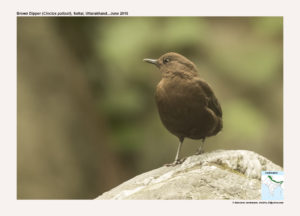Brown Dipper

Brown Dipper Cinclus pallasii
Etymology:
- Cinclus : Greek word kinklos – small, tail-wagging waterside bird
- Pallasii : Named after German naturalist Petrus Simon Pallas (1741–1811)
Vernacular Names: Kash: Dungal, Galkar, Cachar: Di-dao-bui, Lepcha: Nambong-karriak, Bhutia: Chutia-nakka
Distribution in India: Resident of Himalayas and North East India
Description: Size of 19-20 cm. wt. of 70-86 g. The nominate race has plumage entirely dark chocolate-brown, back and chest slightly warmer, more rufous-tinged, than head and rump; flight-feathers and tail dark chocolate-brown; underwing dark grey-brown; iris brown, narrow white eye ring; bill blackish; legs blackish-brown. Both the sexes are similar, female somewhat smaller than male. The juvenile is distinctive, dull blackish-brown with conspicuous greyish-white spots on head and throat, greyish-white scalloping on back, breast and belly, contrasting greyish-white edgings on secondaries, tertials and rectrices. Races differ in depth of coloration: race tenuirostris is paler brown than nominate, juvenile also paler, grey-brown with pale spots above, mottled whitish and brown below; race dorjei is darker and smaller than previous, also juvenile more rufous than in other races, blackish- brown with pale rufous spots, less prominent pale fringes on wings and tail.
Habitat: It is found in fast-flowing rocky mountain streams and shallow rivers with clear water; sometimes at upland tarns. From foothills to above 5000 m locally; breeds from as low as 450 m to 4300 m in Himalayas.
Food Habits: It eats Aquatic invertebrates & larvae of caddis flies also small fish. Forages on riverbed, by diving from rock into fast-flowing water. Swims on surface; on calmer pools and tarns, frequently dives from a floating position, with initial slight upward spring
Breeding Habits: They breed in Dec-Aug. They are monogamous; solitary nester. The nest is built by both sexes, taking 7–10 days. The nest is a large globular structure with side entrance, outer wall made largely of moss, inner layer of finer material, small rootlets and leaf ribs , sited in rock crevice or cliff ledge, often directly above flowing water, sometimes among mid-river boulders, sometimes in cave. They lay a clutch of 3–6 eggs. The incubation period is 19–20 days and fledging period is 23–24 days. Nests sometimes parasitized by cuckoos.